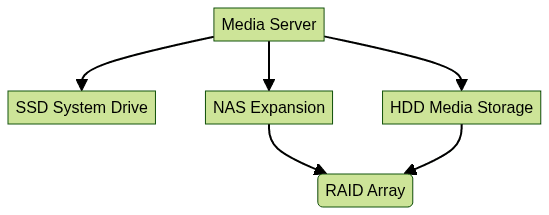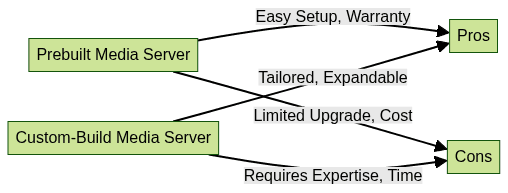Introduction to Hardware for Media Server
A media server is a dedicated system designed to store, organize, and stream multimedia content—such as movies, music, and photos—to multiple devices across a network. Whether you are an enthusiast building a home theater setup or an IT professional deploying a large-scale streaming solution, selecting the right hardware for your media server in 2025 is essential for reliable performance, seamless streaming, and future scalability. The hardware you choose directly impacts everything from transcoding speed and storage capacity to power efficiency and noise levels. This guide dives deep into the best hardware for media servers, considering both home and professional deployments.
Core Hardware Components for Media Server
CPU: The Brain of Your Media Server
The CPU is at the heart of every media server, handling critical tasks like transcoding (converting media files to compatible formats for client devices) and managing multiple concurrent streams. If you plan to stream high-resolution 4K/8K content or support numerous users (as with Plex, Emby, or Jellyfin), invest in a multi-core processor with high single-threaded performance. Modern Intel Core i5/i7/i9, AMD Ryzen 5/7/9, or server-grade Xeon and EPYC CPUs are top choices for media server hardware in 2025. For those interested in integrating real-time features, leveraging a
Live Streaming API SDK
can enhance your server's capabilities for interactive broadcasts.RAM: Memory Matters for Media Server Hardware
RAM ensures smooth multitasking, caching, and responsive user interfaces. For most home media servers, 8-16GB is sufficient. However, media servers handling multiple streams, metadata processing, or running additional services (like Docker containers) benefit from 32GB or more. ECC (Error-Correcting Code) RAM is recommended for professional and mission-critical setups to prevent data corruption. If you plan to add video conferencing features, consider integrating a
Video Calling API
for seamless communication within your network.Storage: SSD vs HDD vs NAS in Media Server Hardware
Storage is where your media library resides. HDDs (Hard Disk Drives) offer large capacity at lower costs, making them ideal for bulk storage. SSDs (Solid State Drives) provide faster access speeds, which can significantly improve server responsiveness, especially for databases and metadata. NAS (Network-Attached Storage) brings expandability and centralized management to the table, perfect for larger or multi-user environments. If you are looking for a
jitsi alternative
for your media server's communication needs, there are several modern solutions available that integrate well with NAS setups.
GPU: When Is It Needed for Media Server Hardware?
A dedicated GPU is not mandatory for most media servers, but it becomes essential for hardware-accelerated transcoding of 4K/8K content. NVIDIA GPUs with NVENC or Intel Quick Sync are popular choices for efficient, high-quality streaming. If you require more advanced streaming features, exploring
livekit alternatives
can help you find the right fit for your server's GPU-accelerated workflows.Choosing the Right Storage Solution
Direct-Attached Storage (DAS) vs Network-Attached Storage (NAS) for Media Server Hardware
DAS connects directly to your server via SATA, USB, or Thunderbolt, offering low latency and simplicity. However, expansion is limited. NAS is a specialized device connected to your network, enabling centralized access, easier scalability, and advanced features like RAID and remote access. For households or small offices, NAS is often the preferred media server hardware storage solution. If you want to
embed video calling sdk
into your media server for collaborative streaming or family calls, NAS solutions can offer the necessary flexibility.RAID Configurations for Media Server Hardware
RAID (Redundant Array of Independent Disks) enhances data protection and performance. Common RAID levels for media servers include RAID 1 (mirrored), RAID 5 (striped with parity), and RAID 6 (dual parity). RAID 5 balances capacity, speed, and redundancy, while RAID 6 offers extra protection. Configure RAID using your OS or dedicated hardware controllers.
1# Example: Create a RAID 5 array in Linux with mdadm
2sudo mdadm --create --verbose /dev/md0 --level=5 --raid-devices=3 /dev/sda /dev/sdb /dev/sdc
3Expandability and Future-Proofing Media Server Hardware
Choose enclosures and motherboards that support hot-swapping drives and offer additional drive bays. This allows you to add storage as your library grows, minimizing downtime and extending the lifespan of your media server hardware. Look for cases with tool-less trays and motherboards with plentiful SATA or NVMe ports. For developers building cross-platform solutions, exploring
flutter webrtc
can help you add real-time communication features to your media server hardware.Connectivity and Networking for Media Server Hardware
Wired vs Wireless: Network Considerations
Wired Ethernet connections provide stability and high bandwidth, crucial for streaming uncompressed or high-bitrate 4K content. While Wi-Fi 6/6E offers impressive speeds, wireless setups are prone to interference and latency—wired remains the gold standard for reliable media server hardware networking. If you are developing for mobile, understanding
webrtc android
can help you optimize streaming and communication on Android devices connected to your server.Ethernet, Wi-Fi, and Advanced Networking Options
Gigabit Ethernet is the baseline for modern media servers. For demanding setups, consider 2.5GbE, 10GbE, or link aggregation. Wi-Fi 6/6E is suitable for mobile devices, but ensure your router and clients support these standards for optimal performance. VLANs and QoS (Quality of Service) can further optimize media traffic. Integrating a
Live Streaming API SDK
can also help you manage and scale interactive streaming sessions across your network.Power Supply and UPS for Reliable Media Server Hardware
A quality power supply (PSU) ensures stable operation and hardware longevity. Look for 80 PLUS Gold or Platinum-rated units. An Uninterruptible Power Supply (UPS) protects against outages and surges, allowing safe shutdown and preventing data corruption.
Home vs Professional Media Server Hardware
Home Theater Media Server Hardware: Key Features
Home setups prioritize quiet operation, energy efficiency, and compact form factors. Mini-ITX or Micro-ATX cases with passive cooling, low-noise fans, and vibration-damped HDD mounts are popular. Integration with smart home systems and support for streaming apps like Plex, Emby, and Jellyfin are essential. For home users who want to add video chat or conferencing, integrating a
Video Calling API
can bring additional value to your media server experience.Professional Media Server Hardware: Scalability and Performance
Professional media servers require rack-mounted enclosures, ECC memory, redundant power supplies, hardware RAID, and hot-swappable drives. These systems are designed for 24/7 operation, multi-room or multi-site streaming, and large-scale storage (often exceeding 100TB). Advanced monitoring, remote management (IPMI), and robust networking (10GbE+) are standard features. For professionals seeking alternatives to traditional conferencing tools, considering a
jitsi alternative
can provide enhanced integration and security for enterprise environments.Noise, Cooling, and Power Efficiency in Media Server Hardware
Passive vs Active Cooling Solutions
Passive cooling uses heat sinks and natural airflow, ideal for silent operation in home environments. Active cooling (fans, liquid coolers) is necessary for high-performance or rack-mounted servers. Choose hardware with optimized airflow paths and quality thermal management to prevent overheating.
Noise Reduction Strategies for Media Server Hardware
Use low-RPM fans, anti-vibration mounting hardware, and sound-dampened cases. Consider SSDs or helium-filled HDDs for quieter operation. Proper cable management also reduces turbulence and noise.
Energy Efficiency and Power Consumption
Select CPUs and PSUs with high efficiency ratings. Enable drive spin-down and sleep modes when idle. Monitoring tools can help optimize energy usage, lowering operating costs and environmental impact.
Popular Prebuilt and Custom Media Server Hardware Options
Prebuilt Media Server Hardware: Pros and Cons
Prebuilt options (e.g., Synology, QNAP, TerraMaster) offer plug-and-play setup, warranty coverage, and integrated software. They save time but may limit customization, upgrade paths, and may cost more for premium features. Ideal for users who value simplicity and reliability. If you want to
Try it for free
, many platforms offer trial versions to help you evaluate their compatibility with your prebuilt hardware.Custom-Build Media Server Hardware: Flexibility and Cost
Custom builds allow tailored component selection—CPU, GPU, RAM, storage, and case—matching your exact requirements and budget. They offer better expandability and performance tuning but require technical know-how and assembly time. DIY setups are perfect for enthusiasts and professionals seeking optimal value. If you are comparing solutions, researching
livekit alternatives
can guide you toward the best fit for your custom media server's communication and streaming needs.Comparison Table: Prebuilt vs Custom Media Server Hardware

Best Practices for Building and Maintaining Media Server Hardware
Regular Backups and Redundancy
Utilize automated backup solutions—local (external drives, NAS) and cloud-based—to protect against data loss. Redundant storage (RAID, SnapRAID) further ensures your media library's safety.
Firmware and Software Updates
Keep your server OS, drive firmware, and media server applications (e.g., Plex, Emby, Jellyfin) up to date. Regular updates patch vulnerabilities and improve performance. If you want to
embed video calling sdk
, ensure your software stack supports the latest integration features.Physical Maintenance and Cleaning
Dust and debris can overheat hardware. Schedule periodic cleaning of fans, filters, and components, and verify airflow. Inspect cabling and connectors for wear, especially in high-uptime environments.
Conclusion: Selecting the Best Hardware for Your Media Server
Choosing the right hardware for your media server in 2025 is a balance between performance, capacity, reliability, and budget. Assess your specific needs (home vs professional), plan for expansion, and prioritize quality components. With the right foundation, your media server will deliver seamless streaming, robust storage, and future-ready flexibility.
Want to level-up your learning? Subscribe now
Subscribe to our newsletter for more tech based insights
FAQ